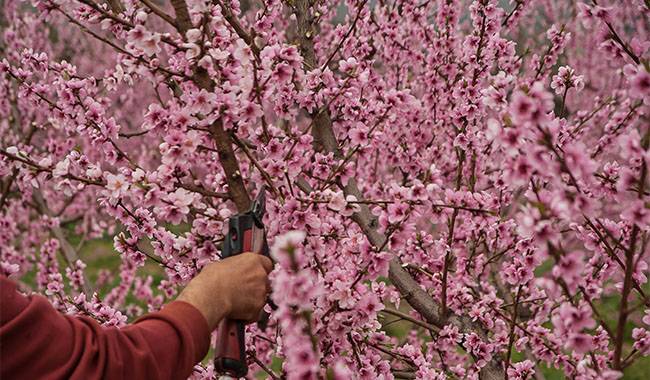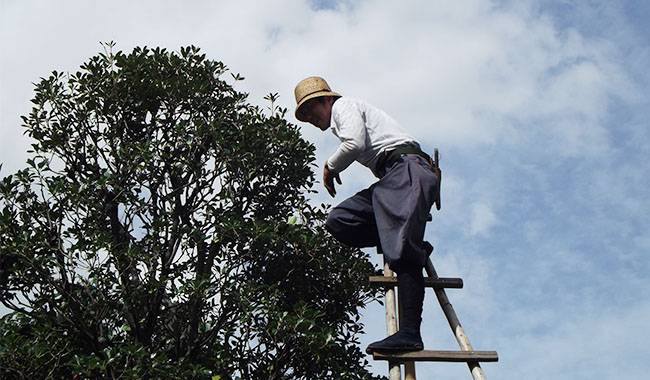
Pruning fruit trees is a scary word for many people, and some garden owners simply ignore pruning, removing only dry and broken shoots. Conversely, some people are so overzealous about pruning that they read only a few articles on the subject and make a whole bunch of mistakes all at once.
And that’s where the mistakes we’re going to discuss today come in. Let those who are afraid pick up the scythe or garden saw again, learn from the mistakes of others, and stop making their own mistakes.
Mistakes in the timing of pruning
Let’s start with timing because many people don’t realize that this is actually very important. One simple truth should be firmly grasped: pruning is the earliest spring activity in the garden, and the best time to prune is in early spring, without the danger of frost, but at least a few weeks before the buds open.
Winter pruning should not be done; it is only allowed in the southern United States, where winter temperatures are barely below our spring temperatures. If you prune fruit trees in winter in our area, the intense frost immediately the following pruning can damage both the bare tissue of the cutting as well as the bark and even the nearby cortex.
As for the exact date of spring pruning, it depends largely on the conditions of a particular year. For example, in the central United States, the best time to prune is in March, when snow usually settles but does not melt completely and pruners can move easily over its surface without getting bogged down.
But whenever you start pruning, as we said, it is important to finish pruning at least a few weeks before the active sap movement starts. During sap flow, which usually begins when the average daily temperature exceeds 41°F (5°C), the roots begin to actively supply water dissolved in minerals to all organs and tissues of the plant through the woody vasculature.
If pruning is completed 12-15 days before sap formation begins, i.e. the cut is kept dry after pruning, the vessels will fill with an air almost immediately and it will clog them like a cork, preventing the release of sap. With this in mind, pruning can in principle be done later, i.e. not two weeks before the sap starts to flow, but a few days before. However, it is sometimes difficult to determine the exact start date of the sap advance, so it is easier, as they say, to play it safe.
If pruning is done later when the vessels are already actively feeding, there is no air entering the vessels and the sap will flow out. The loss of sap will exhaust the plant and the sweet liquid will become bait for various pests and diseases, such as mildew. By infesting shoots, the sooty fungus causes bark stomata to be blocked, reducing air exchange and making the tree less winter hardy.
Pruning beyond the recommended period should only be done if inactivity would have more negative effects on the plant, for example, if a large branch is broken by a strong gust of wind, its further swinging and breaking will only cause more severe bark scratch damage. If you must prune in winter, for example, when branches can break due to excessive snow, you must wait until the first thaw.
Cutting in frosty weather is dangerous because the wood is quite brittle at this time of year and the saw will not cut it but split it, which can lead to burrs and damage to the deeper layers of wood.
In the same case, if a thaw is not expected in the near future and the cutting is urgent, try to leave a stump about 4-4.5inch (10-12cm) long when pruning the branches to be removed. Then all sawed off frost damage and further frost damage will only negatively affect this part of the stump you left behind. In spring, this part can be safely removed.
The wrong regularity of pruning
It’s simple: gardeners, especially beginners, simply don’t pay attention to their fruit trees (pruning-wise) for a long time. This may continue for several years, until they start to bear fruit, or even longer.
Over time, owners of plots with fruit trees notice that their plants are often sick, have poor harvests, and look untidy. They began to prune heavily, using all the pruning techniques they knew. Here’s the mistake: neglected trees used to grow because they want to start getting sick from such exercises and further hinder their development, or multiply a lot of wolves – vertical, thick shoots that pull on most of the nutrients, and the fruit itself does not give.
In fact, you should start regular pruning from the first year of planting seedlings on the plot. If you have a neglected tree, then prune it in parts, removing about a third of the shoots each year, then this will not be very stressful for the plant.
Stumping is also a mistake
Pruning necessarily involves cutting in a “loop”, that is, giving the tree a chance to clear and repair the wound with its own bark. Even if the wound is large, it will still actively begin to form a roll of bark around its edges, which already prevents the area left from the cut from rotting.
If you saw off a branch, leaving a stump, usually 1-1.5inch (3-4cm) long, this almost guarantees that the bark around it will start to rot. The only exception here is forced sawing in frosty winter weather, about whose usefulness we discussed above, and only in this case (again, the exception), you can leave the stump.
Later, if in the spring when sawing we leave the stump, its perimeter begins to destroy the bark, spores of various harmful fungi can “settle” in the garbage left by the bark, various pests can winter here, or the dreaded enemy of any tree – bark beetles can settle.
In any case, the stump left behind when pruning will not do any good, and eventually, the entire base of the knot you left behind will die. But these are visible changes, and there are also invisible changes.
So the stump left behind will visibly interfere with the nutrient runoff from the root system, the tree will weaken even more and begin to reject the stump (usually with some wood), which will lead to the appearance of the hollow, which is already an open door for Chicken of the woods fungus and black cancer.
When pruning a stump left by a once large branch, it usually does not die, and from the dormant buds emerge powerful vertical buds – wolves, which suck up a lot of nutrients and invest only in their own growth, do not form flower buds and, therefore, do not form fruit.
Do you need all these problems? We think not, they can all be avoided by removing the branches completely by “cutting them to the ring”.
Do not unnecessarily cut young growth
As you often notice: budding gardeners cut branches here and there (where necessary, in a haphazard way). This pruning is completely unnecessary for the tree. It is especially dangerous to prune off the tops of trees when they are actively growing. What happens when you do this? By shortening such shoots, you are actually preventing them from growing taller, which leads to the formation of several spikes, instead of the shoots that are now deprived of height and will grow aggressively taller, actually taking all the nutrients from the lateral shoots.
If you prune “young growth” because you want to lengthen the crown and strengthen the skeletal branches, you will need to remove the central branches. Such an easy method will allow you to transfer the growth to the first strongest lateral branch. Then you need to control the condition of the crown, simply do not allow the development of new guide buds, prune them or bend vertical branches, in this state they will begin to grow fruit aggressively, which we are quite satisfied with.

Heavy pruning is also a mistake
This is almost the most common and widespread mistake. Gardeners are sometimes overzealous when it comes to pruning and shortening very strong branches. In doing so, you are actually pushing the growing part of the shootdown as low as if you were removing the branch itself. Obviously, in this case, the uppermost shoot will see itself as the top shoot, and the two closest shoots will be the strongest.
Let’s simulate this situation: you have a shortcut of buds, say four buds. What does this mean? That you have left the plant with only one growing area, and they will absorb all its nutrient solution. This means that you increase growth by pruning and all the branches become main branches at once.
If you cut back a year later, the branches will be stronger and will form real bundles of fat shoots that can only be compensated for by pruning. On the other hand, if you prune it more loosely, to begin with, you won’t be making a bundle, but a branch with bunches of fruit.
Bark scratches – the effect of incorrectly cutting larger branches
It is often necessary to cut large and powerful branches. Such a branch is sometimes impossible for a person to hold with one hand. As a result, it breaks off, has a large bark scratch, and then is handled very long and difficult. So, how do you cut off a large branch? To reduce the weight of the branch, we recommend first cutting off as many side branches as possible.
Then you must cut the branch back about 8inch (20cm) from where the “loop” was cut and file it down to about half of the bottom, then cut close to the trunk but at the top.
This way, the branch will break as expected (in a controlled manner) and the bark will not be scratched. All you have to do is to cut the remaining “stump” into a “ring”.
Neglected sharp corners
Sharp corners are often left out of ignorance. It looks like the branch is growing comfortably, not getting in anyone’s way, not blocking anything, so what if it’s at a 30-degree angle? The truth is, there is nothing good in it. The best angle to handle a branching trunk should be between 45 and 90 degrees, anything less is abnormal.
Later, as the shoot grows, thickens, and gains weight, primary cracks will appear and the shoot will fall directly off the trunk or other branches. A large branch break will form, which will be, firstly, an open portal for infection and, secondly, a very difficult and serious problem to solve.
Sharp branches should be dealt with as early as possible by “cutting” one of them into a ring. Even in cases where the fruit tree forms an additional, ornate-looking shoot above the graft site, which effectively becomes a second trunk, it should be removed as soon as possible.
Unfortunately, by cutting it off, it will flower and bear fruit for a few years, but will then break off from slightly stronger than usual gusts of wind, so that even propping up the branch may not help.
Don’t paint the cutting where it’s wet
In short, a rule of thumb for using garden varnish. Many people are in too much of hurry to apply garden varnish to cut branches immediately after pruning. In fact, you shouldn’t do this: neither garden varnish nor paint will lie on a wet cutting surface. You should wait about 24 hours to allow the cut surface to dry before you start isolating it with garden varnish or garden paint.
These are the basic mistakes you can make when pruning. If you don’t make them, your trees will develop well and give you high and steady yields.







